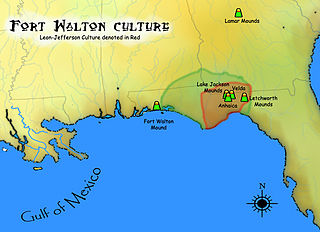Related Research Articles

The Mississippian culture was a Native American civilization that flourished in what is now the Midwestern, Eastern, and Southeastern United States from approximately 800 CE to 1600 CE, varying regionally. It was known for building large, earthen platform mounds, and often other shaped mounds as well. It was composed of a series of urban settlements and satellite villages (suburbs) linked together by loose trading networks. The largest city was Cahokia, believed to be a major religious center located in what is present-day southern Illinois.

Lake Jackson Mounds Archaeological State Park (8LE1) is one of the most important archaeological sites in Florida, the capital of chiefdom and ceremonial center of the Fort Walton Culture inhabited from 1050–1500. The complex originally included seven earthwork mounds, a public plaza and numerous individual village residences.

Joara was a large Native American settlement, a regional chiefdom of the Mississippian culture, located in what is now Burke County, North Carolina, about 300 miles from the Atlantic coast in the foothills of the Blue Ridge Mountains. Joara is notable as a significant archaeological and historic site, where Mississippian culture-era and European artifacts have been found, in addition to an earthwork platform mound and remains of a 16th-century Spanish fort.

Moundville Archaeological Site, also known as the Moundville Archaeological Park, is a Mississippian culture archaeological site on the Black Warrior River in Hale County, near the modern city of Tuscaloosa, Alabama. Extensive archaeological investigation has shown that the site was the political and ceremonial center of a regionally organized Mississippian culture chiefdom polity between the 11th and 16th centuries. The archaeological park portion of the site is administered by the University of Alabama Museums and encompasses 185 acres (75 ha), consisting of 29 platform mounds around a rectangular plaza.

The Fort Walton culture is the term used by archaeologists for a late prehistoric Native American archaeological culture that flourished in southeastern North America from approximately 1200~1500 CE and is associated with the historic Apalachee people.

Clarence Bloomfield Moore, more commonly known as C.B. Moore, was an American archaeologist and writer. He studied and excavated Native American sites in the Southeastern United States.

William Henry Claflin Jr. was a wealthy American businessman and amateur archaeologist. He did archaeological work in Utah and at Stallings Island in Georgia. The Peabody Museum at Harvard University houses a large collection that Claflin collected and donated.
Antonio Johnston Waring Jr., was an amateur archaeologist who made significant contributions to the study of pre-historic southeastern Georgia. He is best known for his role in identifying and defining the Southeastern Ceremonial Complex, together with Preston Holder.
Joseph (Joe) Ralston Caldwell was an American archaeologist was born in Cleveland, Ohio. He conducted major excavations in the Savannah, Georgia area in the late 1930s at the Irene site as part of Depression era archaeology program. He also worked at other archaeology sites in Georgia. During his career he was a professor in the United States and Iran.

The Nacoochee Mound is an archaeological site on the banks of the Chattahoochee River in White County, in the northeast part of the U.S. state of Georgia. Georgia State Route 17 and Georgia State Route 75 have a junction near here.
David G. Anderson is an archaeologist in the department of anthropology at the University of Tennessee, Knoxville, who specializes in Southeastern archaeology. His professional interests include climate change and human response, exploring the development of cultural complexity in Eastern North America, maintaining and improving the nation's Cultural Resource management (CRM) program, teaching and writing about archaeology, and developing technical and popular syntheses of archaeological research. He is the project director of the on-line Paleoindian Database of the Americas (PIDBA). and a Co-Director, with Joshua J. Wells, Eric C, Kansa, and Sarah Whitcher Kansa, of the Digital Index of North American Archaeology (DINAA)
Dan Franklin Morse is an archaeologist specializing in the prehistory of the midwestern United States and the central Mississippi Valley, research summarized in a number of books, monographs, and technical articles. He is best known for his 1983 synthesis of the "Archaeology of the Central Mississippi Valley" with Phyllis A. Morse, and for his 1997 volume issued by the Smithsonian Institution Press on "Sloan: A Paleoindian Dalton Cemetery in Arkansas." The Sloan site is the location of the oldest marked cemetery found to date in the Americas. He conducted excavations on a great many other significant archaeological sites during his career, including at Brand, Cahokia, Nodena, Parkin, and Zebree. Morse retired from his posts as Survey Archeologist for the Arkansas Archaeological Survey and as Professor of Anthropology at the University of Arkansas in 1997, after 30 years of service, but continues to work on publications and interact with students and colleagues on sites.

Poverty Point State Historical Site is a prehistoric earthwork constructed by the Poverty Point culture. The Poverty Point site is located in present-day northeastern Louisiana though evidence of the Poverty Point culture extends throughout much of the Southeastern Woodlands. The culture extended 100 miles (160 km) across the Mississippi Delta and south to the Gulf Coast. The Poverty Point site has been designated as a U.S. National Monument, a U.S. National Historic Landmark, and UNESCO World Heritage Site. Located in the Southern United States, the site is 15.5 miles (24.9 km) from the current flow of the Mississippi River, and is situated on the edge of Macon Ridge, near the village of Epps in West Carroll Parish, Louisiana.
Clarence H. Webb was an American medical doctor and archaeologist who conducted extensive research on prehistoric sites in the southeastern United States. A pediatrician by profession, he became interested in archaeology on a camping trip with his sons where he found some small, triangular points. A distinguished physician, his archaeological research included the study of Caddoan culture, and at a number of major sites such as Poverty Point, John Pearce, Gahagan, and Belcher Mound.
Charles Harrison McNutt is an American archaeologist and a scholar of the prehistoric Southeastern United States. He has conducted fieldwork and published works on the archaeology of the American Southwest and the Great Plains in South Dakota. His work emphasizes on a strong understanding of cultural history and statistical analysis.
The Wilbanks Site (9CK5) is a Late Mississippian culture Native American archaeological site in Cherokee County, Georgia, United States. The site was located about midway between the towns of Cartersville, Georgia to the west, and Canton, Georgia to the east. It was on the south bank of the Etowah River, but is now submerged underneath Lake Allatoona, under roughly 80–90 feet of water.

The Lamar Mounds and Village Site (9BI2) is an important archaeological site on the banks of the Ocmulgee River in Bibb County, Georgia, several miles to the southeast of the Ocmulgee Mound Site. Both mound sites are part of the Ocmulgee Mounds National Historical Park, a national park and historic district created in 1936 and run by the U.S. National Park Service. Historians and archaeologists have theorized that the site is the location of the main village of the Ichisi encountered by the Hernando de Soto expedition in 1539.

Mound 34 is a small platform mound located roughly 400 metres (1,300 ft) to the east of Monks Mound at Cahokia Mounds near Collinsville, Illinois. Excavations near Mound 34 from 2002–2010 revealed the remains of a copper workshop, although the one of a kind discovery had been previously found in the late 1950s by archaeologist Gregory Perino, but lost for 60 years. It is so far the only remains of a copper workshop found at a Mississippian culture archaeological site.

Long Swamp Site is a 4-acre (16,000 m2) archaeological site in Cherokee County, Georgia, United States, on the north shore of the Etowah River near St Rt 372. The site consists of a South Appalachian Mississippian culture village with a palisade and a platform mound.
References
- ↑ Toner, Mike (November–December 2008). "City Beneath the Mounds". Archaeology. 61 (6).
- ↑ Eubanks, Thomas Hales (Winter 2004). "Legislation, legacy, and Larson: Lewis H. Larson, Georgia's first State Archaeologist". Southeastern Archaeology. 23 (2): 214–218.
- ↑ "Lewis H. Larson, Jr. Volunteer Program". University of West Georgia. Archived from the original on January 3, 2013. Retrieved March 7, 2013.